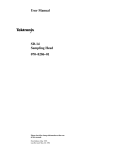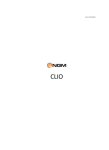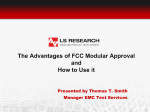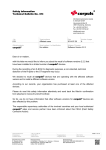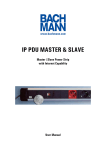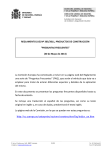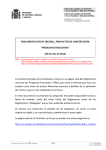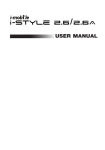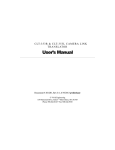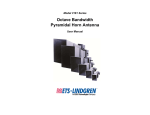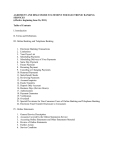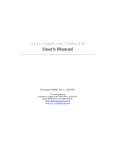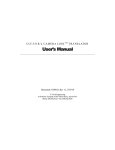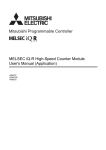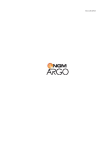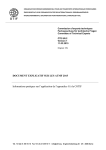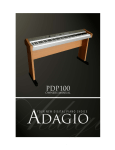Download TCB User`s Manual - BZT - TCP Certification GmbH
Transcript
TCB User’s Manual Introduction On December 17, 1998, the US- Federal Communications Commission (FCC) adopted new rules (47 CFR 2.961-2.962) for the establishment of Telecommunication Certification Bodies (TCB). A TCB is a private organisation, which is authorised to issue grants of equipment authorisation for equipment subject to the Certification procedure. No application to the FCC is required. Under these rules, a TCB will have the authority to review and grant an application for Certification for the FCC. Equipment subject to Certification and Declaration of Conformity (DoC) may be certified by a TCB. PHOENIX TESTLAB GmbH (PTL) is a private organisation that is authorised as a TCB to issue grants of equipment authorisation for equipment subject to the Certification procedure. Therefore PTL is accredited according to EN ISO/IEC 17025 and EN 45011 and designated as a Telecommunication Certification Body (TCB) by the German Federal Ministry of Economics and Technology (BMWi). As a TCB, PHOENIX TESTLAB · Is empowered to certify products in accordance with the US- rules · Must provide fair and equitable treatment · Must accept test data from any source, subject to subcontracting clause in ISO Guide 65 (EN 45011) and shall not unnecessary repeat tests · May rescind grant with 30 days Ersteller: Erstelldatum: H. Bentje 04.01.02 Revision: 02 Datum: 02.04.04 Seite 1 von 13 Authorisation under the TCB program operated by PTL As a TCB, PTL is designated to certify the following scopes of equipment: Unlicensed Radio Frequency Devices 1. Low power transmitters operating on frequencies below 1 GHz, emergency alert systems, unintentional radiators (e.g., personal computers and associated peripherals and TV Interface Devices) and consumer ISM devices subject to certification (e.g., microwave ovens, RF lighting and other consumer ISM devices) 2. Low power transmitters operating on frequencies above 1 GHz 3. Unlicensed Personal Communication System (PCS) devices 4. Unlicensed National Information Infrastructure (UNII) devices and low power transmitters using spread spectrum techniques Licensed Radio Service Equipment 5. Personal Mobile Radio Services in 47 CFR Parts 22 (cellular), 24, 25, 26, and 27 Who can use the program? Manufacturers of Radio Frequency (RF) devices or Telecom Terminal Devices which require a Certification from the FCC prior to marketing of their device in the United States can use the program to obtain the required grant faster than from the traditional process. Agents and laboratories which assemble Certification applications for manufacturers can submit those applications for processing to PTL rather than the FCC. An applicant or his agent must approach the FCC directly for certain services. The following limitations apply to all TCBs: According to CFR 47 §2.962, a TCB may not · Issue a grantee code. · Revoke a grant after 30 days. · Grant a waiver of the rules, or certify equipment for which the Commission rules or requirements do not exist or for which the application of the rules or requirements is unclear. · Take enforcement actions; or · Authorize a transfer of control of a grantee. Ersteller: Erstelldatum: H. Bentje 04.01.02 Revision: 02 Datum: 02.04.04 Seite 2 von 13 Additionally, a TCB cannot certify devices currently excluded to the RF exposure: Transmitters included in a TCB Scope and identified in the following do not qualify for TCB approval.1 Review & Approval procedures are described in a separate document that will be revised as evaluation and approval procedures are updated. Transmitter Category I) All Transmitters II) Portable Transmitters Exclusions List a) devices not evaluated according to most recent versions of FCC OET 65 Supplement C or other applicable FCC policies, procedures, and TCB training notes b) applications for equipment approval or permissive change requiring any change in equipment class (e.g., TNB to TNE, etc.) or change in RF exposure limits or exposure category c) devices employing numerical simulation or computational modeling techniques to show RF exposure compliance d) transmitters operating in non-US protocols or radio services (e.g., PHS, etc.) a) devices with operating frequencies above 6 GHz b) devices in standalone configurations with output power1 greater than the high threshold2 c) transmitters that are implanted or operated within a person’s body d) devices operating according to occupational exposure requirements, except for push-to-talk radios e) devices containing multiple transmitters that transmit simultaneously, when routine SAR evaluation3 is required for the highest output (dominant) transmitter, and any of the other (non-dominant) transmitters is operating at higher than 5 mW f) devices containing multiple transmitters with simultaneous transmission, when routine SAR evaluation is not required, and the sum of the individual ratios of the output power divided by the high threshold is greater than one (1) g) modules for operation in licensed services that are not configured in a dedicated host device h) unlicensed modules used alone or with another transmitter 1) without simultaneous transmission, and the output power of any transmitter is greater than 100 mW with operating frequency less than or equal to 3 GHz OR 50 mW with frequency greater than 3 GHz but less than or equal to 6 GHz 2) with simultaneous transmission, and the sum of the individual ratios of the output power divided by the low threshold2 is greater than one (1) 1 Each TCB location must have a least one person on staff who has completed the Part 22 Subpart H and Part 24 Subpart E handset SAR training, and the fixed, mobile, and portable transmitters RF exposure procedures training. Additional training will be provided in the future on requirements for new procedures and technology. Training workshops will be repeated as necessary to accommodate new TCBs. 2 Output power for portable transmitters is the higher of the conducted or radiated (EIRP) source-based time-averaged output. 3 In the following table, fGHz is mid-band frequency in GHz, and d is the distance to a person’s body, excluding hands, wrists, feet, and ankles. Exposure category low threshold high threshold general population (60/fGHz) mW, d < 2.5 cm (120/fGHz) mW, d ³ 2.5 cm (900/fGHz) mW, d < 20 cm occupational (375/fGHz) mW, d < 2.5 cm (900/fGHz) mW, d ³ 2.5 cm (2250/fGHz) mW, d < 20 cm 4 Routine SAR evaluation refers to that specifically required by § 2.1093, using measurements or computer simulation. When routine SAR evaluation is not required, portable transmitters with output power greater than the applicable low threshold require SAR evaluation to qualify for TCB approval. Ersteller: Erstelldatum: H. Bentje 04.01.02 Revision: 02 Datum: 02.04.04 Seite 3 von 13 FCC Rules and Regulations Applicants for equipment authorisation of radio frequency devices are advised to purchase a copy of Volume I and/or II of the current edition of the FCC Rules, 47 CFR, Parts 0-19 / Parts 20-39 for complete information. Administrative and application procedural rules are in Subpart J of Part 2. The FCC Rules and technical standards for the licensed radio services may be found in other parts of the FCC Rules. The FCC Rules are available free of charge on the FCC website: http://www.FCC.gov. Ersteller: Erstelldatum: H. Bentje 04.01.02 Revision: 02 Datum: 02.04.04 Seite 4 von 13 Equipment Authorisation Most electrical and electronic equipment emit radio frequency energy and therefore are capable of causing harmful interference to radio communications. As such, many devices, such as, computers, transmitters, VCRs, radio receivers, etc. are subject to FCC technical and administrative requirements. Depending on the type, a device may be subject to a FCC equipment authorisation. There are three types of FCC authorisations: · Certification, · Declaration of Conformity or · Verification. The type of equipment authorisation required for each kind of device is specified in the rule part for that equipment: Verification Declaration of Conformity Certification Most ISM equipment Cable Sys Term. Device Cable Sys Term Device TV & FM receivers PC’s & peripherals All other digital devices Most receivers Most receivers Pt-to-Pt Microwave TV Interface Devices TV Interface Devices Broadcast transmitters Consumer ISM eqmt. Consumer ISM eqmt. Aux. Broadcast Xmtrs Telephone Terminal Equipment: SDoC with ACTA Telephone Terminal Equipment PC’s & peripherals* INMARSAT equipment Most transmitters 406 MHz ELT Scanning Receivers CATV Relay Xmtrs Part 11 EAS * The FCC no longer approve Digital Devices subject to DoC, however, a TCB may continue to certify such equipment. Ersteller: Erstelldatum: H. Bentje 04.01.02 Revision: 02 Datum: 02.04.04 Seite 5 von 13 VERIFICATION A self-approval process that requires tests to be performed on the device to be authorized. The manufacturer (or importer) is required to ensure that the measurements necessary to determine compliance with the technical standards are performed. Devices subject to Verification include business computer equipment (Class A); TV and FM receivers; and, nonconsumer Industrial, Scientific and Medical Equipment. Verified devices must be uniquely identified with a brand name and/or model number that cannot be confused with other devices on the market. There is no filing with the FCC or a TCB required for verified equipment. Any changes may be made to the circuitry, appearance, or other design aspects of the device as long as the manufacturer (importer) has on file updated test data and circuit drawings showing that the equipment continues to comply with the FCC Rules. See Section 2.902 of the FCC Rules for more information about Verification. DECLARATION OF CONFORMITY A self-approval process based on testing completed by a test lab accredited by the National Voluntary Laboratory Accreditation Program (NVLAP) or the American Association of Laboratory Accreditation (A2LA) or a designated accredited laboratory under the terms of an negotiated Mutual Recognition Agreement (MRA). The party responsible for the marketing of the product takes the necessary steps to ensure that the equipment complies with the appropriate technical standards. DoC devices must be properly labelled in accordance with Section 15.19 of the FCC Rules. Devices subject to DoC include Class B personal computers and peripherals; CB receivers, super-regenerative receivers, TV interface device, Consumer ISM equipment, etc. CERTIFICATION A bilateral approval process requiring submittal of an application to the FCC Laboratory or a designated TCB for review and approval of equipment subject to certification. The application must include a complete technical description of the product and a measurement report showing compliance with the FCC technical standards, however, applications submitted to a TCB must comply with the TCB’s requirements (paper or electronic). Devices subject to Certification include: low power transmitters such as cordless telephones, garage door opener controls, radio control toys, and security alarm systems and scanning receivers. Personal computers and peripherals (i.e., printers, video monitors, modems, etc.), super-regenerative receivers and TV interface devices such as VCRs can be certified. MARKETING RULES A Radio Frequency device subject to the FCC Rules must comply with both technical and equipment authorisation requirements, if any, before it can legally be imported or marketed in Ersteller: Erstelldatum: H. Bentje 04.01.02 Revision: 02 Datum: 02.04.04 Seite 6 von 13 the US. The marketing rules and importation rules are contained in Subpart I and K, respectively, of Part 2 of the FCC Rules and Regulations. See http://www.fcc.gov/oet/info/rules. Choice of Test Facility As a TCB, PHOENIX TESTLAB accepts test data from a manufacturer or independent laboratory for purposes of equipment certification. Applicants are responsible for ensuring the accuracy and relevance of the test data. PTL will review the data in order to do the conformity assessment of the sample. Alternatively, PTL can perform the required tests itselves on a contract basis with the applicant for certification of the product. For Certification of devices under 47CFR, the test facility description must be on file with the FCC as specified in 47 CFR 2.9.48 (FCC list of laboratories). Format of Applications All applications shall be submitted in electronic format or additional fees will be charged for processing. Files submitted in Adobe PDF- or JPG format on CD-ROM or by E-mail are preferred. Other formats are acceptable after consultation. PTL is required to submit the electronic application files to the FCC after PTL has completed the review. In order to keep certification costs under control, PTL requires the applicant to submit your application in the format required by the FCC database. The FCC database accepts files of certain categories. An application must consist of at least one file from each category marked with a *. Applications cannot be submitted as a single file, but must be submitted as a collection of files of the various categories. More than one file of each category may be submitted. Applicants are encouraged to limit individual file sizes to 4 megabytes. Application information shall conform with 47 CFR 2.1033 requirements. FRN Number Please provide the applicant’s FRN number. The FRN number is assigned by the FCC to each applicant to track the company and it’s compliance with FCC rules. If the applicant does not have an FRN number, one can be obtained from the FCC web site at www.fcc.gov e-filing page. Cover Letters* Included in this category are documents explaining the service you are requesting from PTL and letters requesting confidentiality of some application elements. Please include in your cover letter the FCC ID of a previously approved similar device, if it exists. Ersteller: Erstelldatum: H. Bentje 04.01.02 Revision: 02 Datum: 02.04.04 Seite 7 von 13 Application Checklists All applicants are encouraged to use application checklists. These checklists are designed to inform the applicant as to the review elements that are checked as a minimum in application review by the TCB. Used as a tool by the applicant, these checklists should reduce the amount of information requests from the TCB and improve the probability that the equipment grant will be issued immediately upon completion of first review. 731 Form* The applicant must fill out and submit a completed FCC Form 731. ID Label/Location Info* All devices authorized under the above authorisation procedures are required to display an identification label/plate showing the FCC Identifier (FCC ID) under which they are authorized. See Sections 2.925 and 2.926 for detailed labelling requirements. Additional labelling requirements may be specified in the FCC Rules (in particular see 15.19) governing the particular class of equipment. Applicant/Grantee Code. If you have a device that requires Certification and you are a first time filer, you MUST obtain an Applicant/Grantee Code. Please refer to the FCC website for detailed information http://www.fcc.gov. External Photos* Good quality (1M pixels or greater) showing the exterior of the product from all sides. These photos cannot be kept confidential. Internal Photos* Good quality (1M pixel or greater) showing the inside of the product and BOTH sides of all printed circuit cards. Confidentiality may be requested for internal photos. Test set-up photos* Photos, which provide documentation of cable and equipment configuration, which produced the worst case, radiated and conducted emissions. Front and back photos are required. Typically four individual photos. Ersteller: Erstelldatum: H. Bentje 04.01.02 Revision: 02 Datum: 02.04.04 Seite 8 von 13 Operational Descriptions* A brief description of the circuit functions of the device along with a statement describing how the device operates. This statement should contain a description of the ground system and antenna, if any, used with the device. Block Diagrams* A block diagram showing the frequency of all oscillators in the device. The signal path and frequencies shall be indicated at each block. The tuning range(s) and intermediate frequency(ies) shall be indicated at each block. Schematics* A schematic diagram of the device. Schematics must be formatted as U. S. A size (approx. 21.5cm x 28cm). Test Report* A report of the measurements showing compliance with the pertinent FCC technical requirements. This report shall identify the test procedure used (e.g., specify the FCC test procedure, or industry test procedure that was used), the date the measurements were made, the location where the measurements were made, and the device that was tested (model and serial number, if available). The report shall include sample calculations showing how the measurement results were converted for comparison with the technical requirements. The report shall document the accreditation status of the test facility and submit the accreditation certificate and scope of accreditation. User’s manual* A copy of the user’s manual for the device with the location of any required FCC inserts clearly identified by page number reference either in the cover letter or on the first page of this exhibit. Parts List/ Tune-up info If applicable to the device. Ersteller: Erstelldatum: H. Bentje 04.01.02 Revision: 02 Datum: 02.04.04 Seite 9 von 13 RF Exposure Info* A discussion documenting the device compliance with the requirements of 1.1310, 2.1091, and/or 2.1093 as applicable. Devices categorically excluded from routine RF exposure must still file an analysis indicating that they comply with RF exposure limits. Confidentiality requests In order for any application file to have an opportunity to be treated as confidential by the FCC, a section of the cover letter file must make a specific request for confidentiality in accordance with 47 CFR 0.459. The request must specify the application files, which are requested to be confidential. If a portion of a category of application file contains both confidential and non-confidential information, split the file into two files and submit both with one identified as confidential. All materials, information, verbal conversations, and correspondence to PTL is made available by PTL to the FCC. The FCC is a federal agency and as such has duties to the public to disclose information made know to it (see 47 CFR Part 0). The FCC has a procedure in 47 CFR 0.459 for requesting that certain items of an application be kept confidential. PTL will pass such requests along to the FCC, which will decide when, and if, to honor those requests. At this time it is not determined if US law allows a Freedom of Information Act request to apply to a TCB acting under authority granted by the FCC. Applicants are cautioned to carefully consider the information that they disclose to PTL. Designating an application file as confidential does not mean that the FCC will treat that application file as confidential. After a request is made, the FCC will determine what files it will treat as confidential. Ersteller: Erstelldatum: H. Bentje 04.01.02 Revision: 02 Datum: 02.04.04 Seite 10 von 13 Surveillance Activities The FCC requires a certification body to perform surveillance activities. We are expected to test at least several samples each year for the various types of products we have certified. If the product fails to comply with the FCC rules during the auditing process, we have to inform the FCC and the grantee immediately. Part 2 of the FCC Rules requires a TCB to conduct appropriate post-market surveillance activities in accordance with ISO/IEC Guide 65. 1. The post-market surveillance audit consists of the following: i. When selecting the samples to be audited the TCB should give consideration to the following: (1) New technologies. (2) New applicant. (3) New test laboratory. (4) Products with a history of non-compliance. (5) Products whose test report may be sufficient for approval but raise a question for continued compliance. (6) Request from the FCC for an audit to be performed on specific product types. ii. Annually the number of product types audited by the TCB shall consist of at least 2 percent of the total number of products certified by the TCB, following the guidance in paragraph (i) above. If the TCB has certified products subject to the RF Radiation Exposure requirements, then at least 1 percent of those products shall be audited by the TCB. (The number of products audited shall be rounded up to the next whole number.) iii. The TCB may obtain a sample by one of the following methods: (1) Request the grantee to submit a sample of the product certified. (2) Buy a sample product locally. (3) Request a sample from the grantee prior to grant of certification. (4) The FCC is to be notified when the grantee refuses or fails to reply to after two requests for a sample. iv. Ersteller: Erstelldatum: The sample is tested by the TCB, to determine compliance with the Commission’s Rules. H. Bentje 04.01.02 Revision: 02 Datum: 02.04.04 Seite 11 von 13 v. The TCB evaluates the sample to determine compliance with the Commission’s labeling and user instruction requirements. 2. If during the auditing process the TCB finds that a product fails to comply with the FCC requirements, the TCB shall immediately notify the grantee and the FCC. 3. A follow-up report shall be provided to the FCC by the TCB, within 30 days of the notification of non-compliance, of the action taken or that will be taken by the grantee to correct the situation. 4. The TCB shall submit to the FCC, within 30 days of such a request, reports of surveillance activities carried out by the TCB. 5. The TCB may be required to test a product certified by the TCB and report its findings to the FCC within 30 days to support compliance investigations. Ersteller: Erstelldatum: H. Bentje 04.01.02 Revision: 02 Datum: 02.04.04 Seite 12 von 13 Fee Schedule Please ask for a detailed quotation for your device at: PHOENIX TESTLAB GmbH Telecom. Certification Body Königswinkel 10 D-32825 Blomberg Germany Phone: Fax: E-mail: Website : Ersteller: Erstelldatum: H. Bentje 04.01.02 +49-5235-9500-24 +49-5235-9500-28 [email protected] http://www.phoenix-testlab.de Revision: 02 Datum: 02.04.04 Seite 13 von 13













